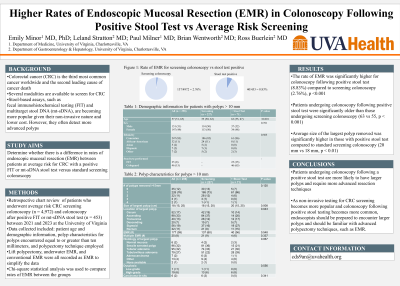Monday Poster Session
Category: General Endoscopy
P1977 - Higher Rates of Endoscopic Mucosal Resection (EMR) in Colonoscopy Following Positive Stool Test vs Average Risk Screening
Monday, October 23, 2023
10:30 AM - 4:15 PM PT
Location: Exhibit Hall

Has Audio

Emily Minor, MD, PhD
University of Virginia
Charlottesville, VA
Presenting Author(s)
Award: Presidential Poster Award
Emily Minor, MD, PhD, Leland Stratton, MD, Paul Milner, MD, Ross Buerlein, MD
University of Virginia, Charlottesville, VA
Introduction: Colorectal cancer (CRC) is the third most common cancer worldwide and the second leading cause of cancer death. Several modalities are available to screen for CRC including endoscopy, colonography, and stool-based assays. Newer methods of stool testing, such as fecal immunohistochemical testing (FIT) and multitarget stool DNA (mt-sDNA), are becoming more popular given their non-invasive nature and lower cost. However, positive FIT and mt-sDNA tests have been associated with more advanced polyps than screening colonoscopy. We sought to determine whether there is a difference in rates of endoscopic mucosal resection (EMR) between patients at average risk for CRC with a positive FIT or mt-sDNA versus standard screening colonoscopy.
Methods: A retrospective chart review was conducted on patients who underwent average risk CRC screening colonoscopy (n = 4,972) and colonoscopy after positive FIT or mt-sDNA stool test (n = 453) between 2021 and 2023 at the University of Virginia. Patients were excluded if they had a prior history of polyps, were not average risk for CRC, or if stool testing was ordered inappropriately. Results obtained included patient age and demographic information, polyp characteristics for polyps encountered equal to or greater than ten millimeters, and polypectomy technique employed. Lift polypectomy, underwater EMR, and conventional EMR were all recorded as EMR to simplify the data. Chi-square statistical analysis was used to compare rates of EMR between the groups. The secondary outcome was comparison of polyp characteristics.
Results: The rate of EMR was significantly higher for colonoscopy following positive stool test (8.83%) compared to screening colonoscopy (2.76%), p < 0.001. Average size of the largest polyp removed was significantly higher in those with positive stool test compared to standard screening colonoscopy (20 mm vs 18 mm, p < 0.01). There was no significant difference in patient age, sex or demographics between the groups.
Discussion: Patients undergoing colonoscopy following a positive stool test are more likely to have larger polyps and require more advanced resection techniques such as EMR. As non-invasive testing for CRC screening becomes more popular and colonoscopy following positive stool testing becomes more common, endoscopists should be prepared to encounter larger polyps and should be familiar with advanced polypectomy techniques.
Disclosures:
Emily Minor, MD, PhD, Leland Stratton, MD, Paul Milner, MD, Ross Buerlein, MD. P1977 - Higher Rates of Endoscopic Mucosal Resection (EMR) in Colonoscopy Following Positive Stool Test vs Average Risk Screening, ACG 2023 Annual Scientific Meeting Abstracts. Vancouver, BC, Canada: American College of Gastroenterology.
Emily Minor, MD, PhD, Leland Stratton, MD, Paul Milner, MD, Ross Buerlein, MD
University of Virginia, Charlottesville, VA
Introduction: Colorectal cancer (CRC) is the third most common cancer worldwide and the second leading cause of cancer death. Several modalities are available to screen for CRC including endoscopy, colonography, and stool-based assays. Newer methods of stool testing, such as fecal immunohistochemical testing (FIT) and multitarget stool DNA (mt-sDNA), are becoming more popular given their non-invasive nature and lower cost. However, positive FIT and mt-sDNA tests have been associated with more advanced polyps than screening colonoscopy. We sought to determine whether there is a difference in rates of endoscopic mucosal resection (EMR) between patients at average risk for CRC with a positive FIT or mt-sDNA versus standard screening colonoscopy.
Methods: A retrospective chart review was conducted on patients who underwent average risk CRC screening colonoscopy (n = 4,972) and colonoscopy after positive FIT or mt-sDNA stool test (n = 453) between 2021 and 2023 at the University of Virginia. Patients were excluded if they had a prior history of polyps, were not average risk for CRC, or if stool testing was ordered inappropriately. Results obtained included patient age and demographic information, polyp characteristics for polyps encountered equal to or greater than ten millimeters, and polypectomy technique employed. Lift polypectomy, underwater EMR, and conventional EMR were all recorded as EMR to simplify the data. Chi-square statistical analysis was used to compare rates of EMR between the groups. The secondary outcome was comparison of polyp characteristics.
Results: The rate of EMR was significantly higher for colonoscopy following positive stool test (8.83%) compared to screening colonoscopy (2.76%), p < 0.001. Average size of the largest polyp removed was significantly higher in those with positive stool test compared to standard screening colonoscopy (20 mm vs 18 mm, p < 0.01). There was no significant difference in patient age, sex or demographics between the groups.
Discussion: Patients undergoing colonoscopy following a positive stool test are more likely to have larger polyps and require more advanced resection techniques such as EMR. As non-invasive testing for CRC screening becomes more popular and colonoscopy following positive stool testing becomes more common, endoscopists should be prepared to encounter larger polyps and should be familiar with advanced polypectomy techniques.
Disclosures:
Emily Minor indicated no relevant financial relationships.
Leland Stratton indicated no relevant financial relationships.
Paul Milner indicated no relevant financial relationships.
Ross Buerlein indicated no relevant financial relationships.
Emily Minor, MD, PhD, Leland Stratton, MD, Paul Milner, MD, Ross Buerlein, MD. P1977 - Higher Rates of Endoscopic Mucosal Resection (EMR) in Colonoscopy Following Positive Stool Test vs Average Risk Screening, ACG 2023 Annual Scientific Meeting Abstracts. Vancouver, BC, Canada: American College of Gastroenterology.

